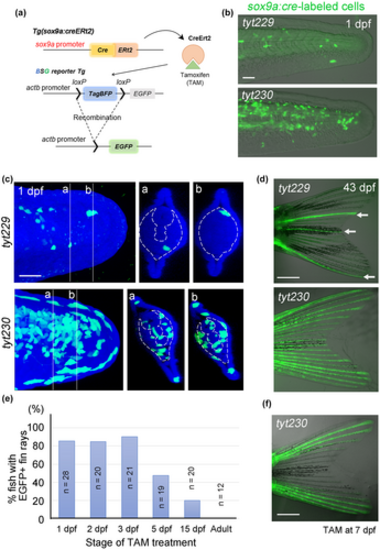Fig. 1
- ID
- ZDB-FIG-240221-8
- Publication
- Komiya et al., 2024 - Independent mesenchymal progenitor pools respectively produce and maintain osteogenic and chondrogenic cells in zebrafish
- Other Figures
- All Figure Page
- Back to All Figure Page
|
Generation of the zebrafish Tg(sox9a:creERt2) lines. (a) Schematic illustration of cell labeling using Cre/loxP recombination. The double Tg of the Cre-expressing line under the control of the sox9a promoter and the loxP reporter line, Tg(Olactb:loxP-bfp-loxP-egfp), was treated with 4-hydroxytamoxifen (TAM) to induce recombination at the loxP sites. (b) Recombination efficiencies in two Cre Tg lines, tyt229 and tyt230. tyt230 displayed a higher number of EGFP+ cells than tyt229. Scale bar, 50 μm. (c) Confocal images of Cre-labeled cells (left panels) and their optical sections at positions a and b (right panels). EGFP+ cells were mainly present in the somites (dotted lines). Scale bars, 50 μm. (d) Contribution of Cre-labeled cells to adult fin rays. Representative images of adult fins labeled with TAM at 0–1 days post-fertilization (dpf). Most fin rays contained EGFP+ cells in tyt230, whereas only a few fin rays contained EGFP+ cells in tyt229 (arrows). Scale bar, 500 μm. (e) Quantification of fish with EGFP+ fin rays in tyt230. For TAM treatment, 5 μM TAM was given for 2 h starting from the indicated time points, and the number of fish with fin rays containing EGFP+ cells was scored. Labeling declined during the early larval stages. (f) Typical image of a labeled fin ray in tyt230 treated with TAM at 7 dpf. Only a few fin rays in the dorsal and ventral regions were labeled. Scale bar, 500 μm. |

